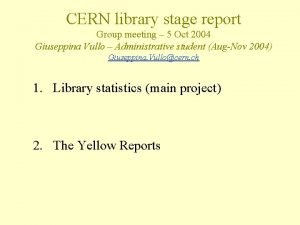THE MERIT HIGHPOWER TARGET EXPERIMENT AT THE CERN

- Slides: 1

THE MERIT HIGH-POWER TARGET EXPERIMENT AT THE CERN PS (WEPE 078, IPAC 10) K. T. Mc. Donald*, Princeton University, Princeton, NJ 08544, USA H. G. Kirk, H. Park, T. Tsang, BNL, Upton, NY 11973, USA I. Efthymiopoulos, A. Fabich, F. Haug, J. Lettry, M. Palm, H. Pereira, CERN, CH-1211 Genéve 23, Switzerland N. Mokhov, S. Striganov, FNAL, Batavia, IL, 60510, USA A. J. Carroll, V. B. Graves, P. T. Spampinato, ORNL, Oak Ridge, TN 37831, USA P. H. Titus, Princeton Plasma Physics Laboratory, Princeton, NJ 08543, USA J. R. J. Bennett, O. Caretta, P. Loveridge, RAL, Chilton, OX 11 0 QX, UK The MERIT Experiment, which ran at CERN in 2007, is a proof-of-principle test for a target system that converts a 4 -MW proton beam into a high-intensity muon beam for either a neutrino factory complex or a muon collider. The target system is based on a free mercury jet that intercepts an intense proton beam inside a 15 -T solenoidal magnet. SC-1 SC-2 SC-3 SC-4 SC-5 Window Nozzle Tube Proton Beam Iron Plug Resistive Magnet Mercury Drain Mercury Pool Splash Mitigator Water-cooled Mercury Tungsten Shield Jet Concept of a continuous mercury jet target for an intense proton beam. The jet and beam are tilted by 100~mrad and 67~mrad, respectively, with respect to a 20 -T solenoid magnet that conducts low -momentum pions into a decay channel. Cutaway view of the MERIT experiment. The solenoid/Hg jet system is tilted by 100~mrad with respect to the beam/floor. The 15 -T magnet is cooled by LN 2 and can be pulsed every 30 min. The Hg jet is 1 -cm in diameter and has a velocity of 20 m/s, which presents a new, 2 -interaction-length target to the beam every 20 ms. Before: During: A 1 -cm diameter, 15 -m/s Hg jet at 0, 75, 175, and 375 s after interaction with 10 1012 24 -Ge. V protons in a 10 -T solenoid field. The velocity of the filamentary dispersal was ~ 40 m/s. After: Above: The disruption of the jet by the beam is confined to the beam/jet interaction region, and is damped by high magnetic fields. PUMP: 12 bunches, 12 1012 protons PROBE: 4 bunches, 4 1012 protons Above: Observed filament velocities, together with a global fit, for various proton beam energies and magnetic field. High magnetic fields damp the velocity. Above : Studies with a second set of proton bunches up to 750 s after the first show negligible reduction in the production of pions. The MERIT Experiment, has demonstrated the a free mercury jet target could be used in pulsed protons beams of power up to 8 MW, taking into account that a strong magnetic field reduces the disruption of the jet by the beam.

